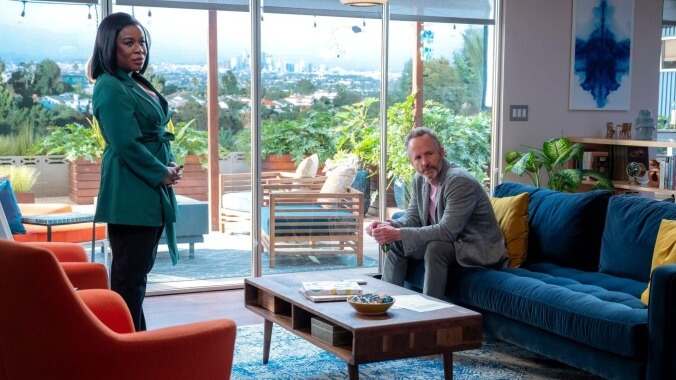HBO’s In Treatment revival is full of immersive and intricate storylines

Uzo Aduba is a powerhouse performer, as witnessed in her Emmy-winning work on Orange Is The New Black and Mrs. America. The actress has an innate ability to enrapture audiences with an emotive performance. Her new series further allows her to fully occupy the frame and do just that: Aduba leads HBO’s revival of In Treatment, which initially ran for three seasons from 2008 to 2011. This reboot (essentially a fourth season) features Aduba’s Dr. Brooke Taylor as the lead instead of Gabriel Byrne’s Dr. Paul Weston. Brooke conducts therapy sessions from her upscale Los Angeles apartment while dealing with personal problems. The show offers the immersive stories of Brooke’s three volatile patients, mostly succeeding in digging into their psyches as well as Brooke’s, even if the journey is convoluted at times. In Treatment attempts to dig into its protagonists’ serious identity issues, unpacking layers of the façades they maintain to hide their real selves from the world.
It’s an enthralling concept that often feels intimate because of the one-on-one setting between Brooke and her patients. This is enhanced by the fact that, due to COVID-19 restrictions, there are no real glimpses of the outside world apart from the view outside Brooke’s immaculate home-turned-office. It’s a reflection of the world during a global lockdown that has caused mental stress for everyone to varying degrees. The importance of therapy is underlined as all parties explore the lies they tell themselves and others in order to be liked or simply to survive. The sessions feel too performative at times and tend to paint some of the characters’ issues in broad strokes without drilling down on them with nuance. (Showtime’s reality docuseries Couples Therapy is a stronger example of the latter.) But In Treatment is anchored by relatable stories and remarkable on-screen talent.
The series is structured around Brooke’s weekly visits with patients, with each episode featuring one prominent session. It kicks off with Eladio (In The Heights’ Anthony Ramos), a gay Latino health aide worker living with a wealthy white family. Eladio suffers from insomnia and develops almost a mother-son like bond with Brooke. As his episodes unfold, his abandonment issues and a former diagnosis become central to his story. The second patient is Colin (John Benjamin Hickey), a tech genius just released from prison after four years for a white collar crime. His outgoing, showy personality masks insecurities as he goes out of his way to talk about his open-mindedness and devotion to social causes. The third patient is Laila (Trinkets’ Quintessa Swindell), an 18-year-old queer Black woman whose grandmother, Rhonda (Charlayne Woodard), forces her to attend therapy before she heads off to college and has to face the world, and the young adult forms her own connection with Brooke.
These are clearly the three clients who affect Brooke the most; they are defensive and frequently question her methods and motives as she patiently tackles their issues and deftly navigates their doubts. But just as she is able to untie their knotty, deflective behaviors, the show increasingly tangles Brooke into her own web of personal drama. Every episode that focuses just on her slowly chips away at her backstory, illuminating the depths of her own grief and coping methods. She’s recently reignited a romance with an ex, Adam (Joel Kinnaman), much to the chagrin of her best friend, Rita (Liza Colón-Zayas). Brooke’s conversations with the latter form the crux of the entries on her life because Rita doesn’t shy away from challenging her, inevitably putting her in the hot seat for a change. “Who holds your pain?” Rita asks her at one point. It’s a heavy question—not just because Brooke is dealing with her own trauma, but because of her identity in the world.
As a Stanford-educated Black woman in a thriving career, Brooke subverts the notions her own clientele has of her. She takes in their pain and outbursts while often having to explain her success. This aspect comes to play the most in her dealings with Colin. He habitually uses micro-aggressions towards her only to immediately overcompensate and say that if he hadn’t been in prison, he’d be first in line to march in support of BLM; kudos to Brooke for not rolling her eyes and tactfully addressing his real narcissism issues instead. Colin’s sessions with Brooke are court-mandated, but their interactions are the most electrifying to watch. Casting an actor of Aduba’s caliber pays off here because she elevates the material with her evocative, empathetic, and skilled performance. Her tête-à-tête with Colin is stirring because of the gravity of the issues they discuss, and Hickey is a solid counterpart to Aduba in their scenes.
However, as much as the show tries to get into the nitty-gritty of Eladio, Colin, and Laila’s problems, it often presents them in a sweeping manner. Laila goes off about climate change, political reform, and her wanderlust fantasies, but her episodes find meaning when Brooke is able to get through her superficiality and connect on a deeper level. Swindell is a clear breakout as Laila, who manages to find deeper layers in her character’s journey even if the dialogue gets unnecessarily complicated at times. Ramos’ scenes occur via video call so while he performs well, the impact of Eladio’s story is dampened. In Treatment is sublime when Brooke is at the center of it—as engaging as her patients’ experiences are, she is the thread that connects them. Understanding her psyche turns out to be the beating heart of the show.